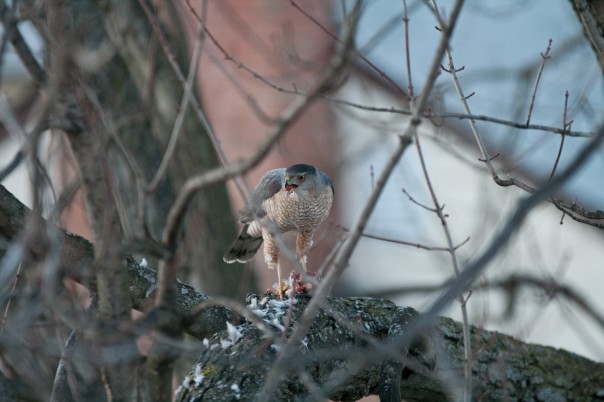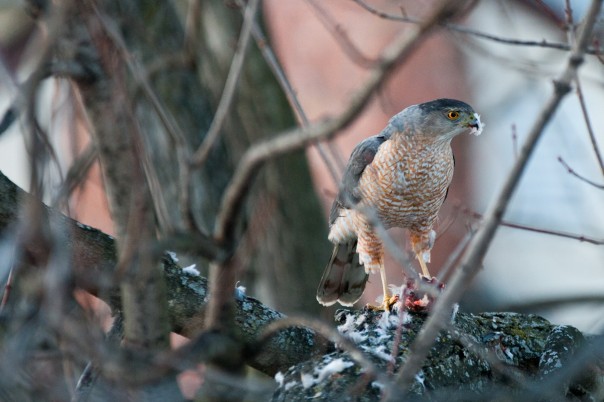A few weeks ago, just around that time of day that’s just past late afternoon, and just before twilight, I was out in the back yard with my dog, Bailey. I spied a bunch of fresh feathers on the ground, and muttered to myself about how I wished the neighbors would keep their cat inside, when a few more feathers fluttered in front of me.
I looked up to see a midsized hawk of some sort perched in the tree, at exactly second floor window height. Seems it wasn’t the neighbor’s cat at all! Of course, it was just past perfect golden light here, as the sun was now obstructed by the buildings to the west, and the light was going more gray every minute.
But there was a hawk, perched not twenty feet out the back windows of my second floor! I raced up to my camera cabinet, grabbed the Sigma APO 70-200 F2.8 EX DG OS HSM lens, threw it on a Rebel XTi , made sure I had a camera card in the camera (an error of omission I’ve made on more than one occasion, I must admit!) and looked for the best angle out the back windows.
I had to try to make a photo, even if the odds were long I’d get a winner. (And while we’re on the subject of winners, the Sigma 70-200 lens I grabbed for this pop-up photo shoot was just named “Best Expert Lens” by TIPA.)
By far, the best angle I could shoot was straight out my office window. But the screen on this window sticks, and I was worried the ruckus in opening the window would spook my avian subject, which at the time, I thought was a Northern Harrier; but there was no time to check the bird guides for a positive ID. I decided to shoot out the bathroom window instead–trading a cleaner background free from structures for the chance to easily pop open the window and screen without scaring off the subject.
In many ways photography is all about compromises. But mostly it is about knowing your gear, and knowing techniques for upping the odds of nailing the shot.
In manual exposure mode, I set ISO to 800 (usually the highest ISO I’ll choose to shoot on the Rebel XTi), aperture to wide open f2.8 (for most blurred background and fastest possible shutter speeds), and the shutter speed to 1/160 (based on partially metering a number of spots on the tree and bird.)
I zoomed all the way to 200mm, focused on the bird, and then switched to manual focus–so the camera wouldn’t search each time I touched the shutter button to grab a shot of this stationary subject.
I activated optical stabilization to minimize camera jitters–since my shutter speed was below the focal length–and fired off a bunch of frames and quickly checked the LCD preview for focal plane sharpness and histogram.
My exposures were right where I wanted them to be. Optical stabilization was keeping the still items in the scene sharp. The odds of getting a frame that I’d be pleased with increased.
Now it was up to me to try to hit the shutter button at the right time, during a moment of engagement or intrigue, when the hawk was still for a fleeting instant between darting swivels and bobs of its sharp-beaked head. Oh yes, and add to all of that I just mentioned that it be at a moment when the lightly swaying twigs in the foreground weren’t significantly obstructing the lines of the subject.

Over the course of seven minutes, I fired off 83 frames, before the hawk flew off. In many of the shots, the hawk’s upper body was moving and is thus blurred in the frames. In many other shots, the bird is too obscured by the branches. Or for whatever reason, the moment and composition just doesn’t feel right, as is the case below.

Of all the frames I made this afternoon, one shot of what turned out to be a Cooper’s Hawk (and not a Northern Harrier as I originally thought) stood out from the pack by a wide margin. The head in profile, with the downy feathers in is beak and the bright orange eye in crisp light make this the shot of the day for me.

Is this the greatest shot of a Cooper’s Hawk ever made? Probably not.
But it is the best shot I’ve ever made of any raptor species in my own backyard under any lighting conditions.
The total time from first spotting the bird to its departure was less than nine minutes. The shutter speed for this shot was 1/160 second.
But there’s more to it than that: all the years of practice, experimentation, learning from past successes and failures, and winning and losing frames helps build us as photographers.
Knowing how to work with the lens and camera to make the most of the moments unfolding before me allowed to focus, as it were, solely on triggering the shutter at what I hoped was the right capture moment. And in a couple of those shutter twitches, I think I nailed it.
Do you have a bird stories and photos to share? Let us know!


I absolutely love my 70-200mm APO EX DG f2.8 Macro Lens. It really gets all the detail, all the time!